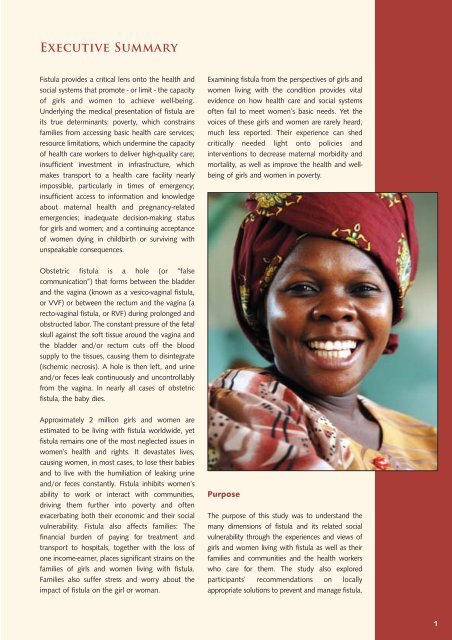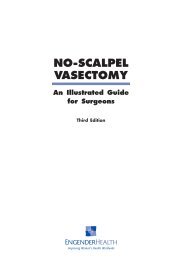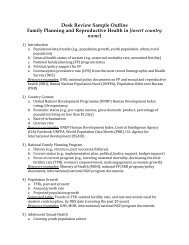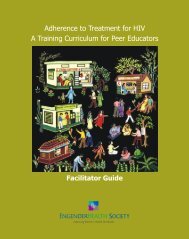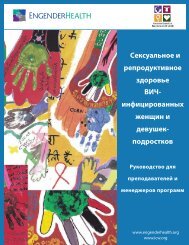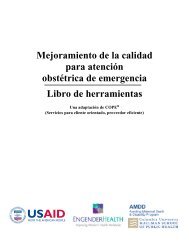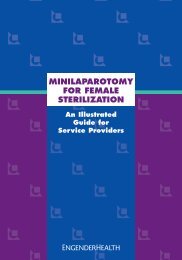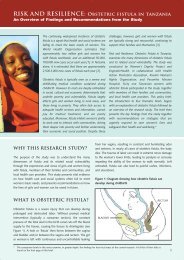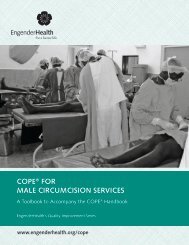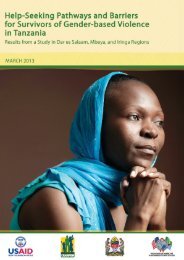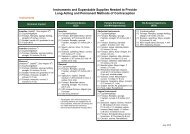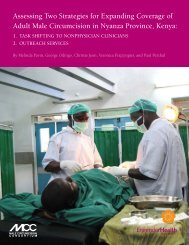Risk and Resilience: Obstetric Fistula in Tanzania - EngenderHealth
Risk and Resilience: Obstetric Fistula in Tanzania - EngenderHealth
Risk and Resilience: Obstetric Fistula in Tanzania - EngenderHealth
Create successful ePaper yourself
Turn your PDF publications into a flip-book with our unique Google optimized e-Paper software.
Executive Summary<br />
<strong>Fistula</strong> provides a critical lens onto the health <strong>and</strong><br />
social systems that promote - or limit - the capacity<br />
of girls <strong>and</strong> women to achieve well-be<strong>in</strong>g.<br />
Underly<strong>in</strong>g the medical presentation of fistula are<br />
its true determ<strong>in</strong>ants: poverty, which constra<strong>in</strong>s<br />
families from access<strong>in</strong>g basic health care services;<br />
resource limitations, which underm<strong>in</strong>e the capacity<br />
of health care workers to deliver high-quality care;<br />
<strong>in</strong>sufficient <strong>in</strong>vestment <strong>in</strong> <strong>in</strong>frastructure, which<br />
makes transport to a health care facility nearly<br />
impossible, particularly <strong>in</strong> times of emergency;<br />
<strong>in</strong>sufficient access to <strong>in</strong>formation <strong>and</strong> knowledge<br />
about maternal health <strong>and</strong> pregnancy-related<br />
emergencies; <strong>in</strong>adequate decision-mak<strong>in</strong>g status<br />
for girls <strong>and</strong> women; <strong>and</strong> a cont<strong>in</strong>u<strong>in</strong>g acceptance<br />
of women dy<strong>in</strong>g <strong>in</strong> childbirth or surviv<strong>in</strong>g with<br />
unspeakable consequences.<br />
Exam<strong>in</strong><strong>in</strong>g fistula from the perspectives of girls <strong>and</strong><br />
women liv<strong>in</strong>g with the condition provides vital<br />
evidence on how health care <strong>and</strong> social systems<br />
often fail to meet women’s basic needs. Yet the<br />
voices of these girls <strong>and</strong> women are rarely heard,<br />
much less reported. Their experience can shed<br />
critically needed light onto policies <strong>and</strong><br />
<strong>in</strong>terventions to decrease maternal morbidity <strong>and</strong><br />
mortality, as well as improve the health <strong>and</strong> wellbe<strong>in</strong>g<br />
of girls <strong>and</strong> women <strong>in</strong> poverty.<br />
<strong>Obstetric</strong> fistula is a hole (or “false<br />
communication”) that forms between the bladder<br />
<strong>and</strong> the vag<strong>in</strong>a (known as a vesico-vag<strong>in</strong>al fistula,<br />
or VVF) or between the rectum <strong>and</strong> the vag<strong>in</strong>a (a<br />
recto-vag<strong>in</strong>al fistula, or RVF) dur<strong>in</strong>g prolonged <strong>and</strong><br />
obstructed labor. The constant pressure of the fetal<br />
skull aga<strong>in</strong>st the soft tissue around the vag<strong>in</strong>a <strong>and</strong><br />
the bladder <strong>and</strong>/or rectum cuts off the blood<br />
supply to the tissues, caus<strong>in</strong>g them to dis<strong>in</strong>tegrate<br />
(ischemic necrosis). A hole is then left, <strong>and</strong> ur<strong>in</strong>e<br />
<strong>and</strong>/or feces leak cont<strong>in</strong>uously <strong>and</strong> uncontrollably<br />
from the vag<strong>in</strong>a. In nearly all cases of obstetric<br />
fistula, the baby dies.<br />
Approximately 2 million girls <strong>and</strong> women are<br />
estimated to be liv<strong>in</strong>g with fistula worldwide, yet<br />
fistula rema<strong>in</strong>s one of the most neglected issues <strong>in</strong><br />
women’s health <strong>and</strong> rights. It devastates lives,<br />
caus<strong>in</strong>g women, <strong>in</strong> most cases, to lose their babies<br />
<strong>and</strong> to live with the humiliation of leak<strong>in</strong>g ur<strong>in</strong>e<br />
<strong>and</strong>/or feces constantly. <strong>Fistula</strong> <strong>in</strong>hibits women’s<br />
ability to work or <strong>in</strong>teract with communities,<br />
driv<strong>in</strong>g them further <strong>in</strong>to poverty <strong>and</strong> often<br />
exacerbat<strong>in</strong>g both their economic <strong>and</strong> their social<br />
vulnerability. <strong>Fistula</strong> also affects families: The<br />
f<strong>in</strong>ancial burden of pay<strong>in</strong>g for treatment <strong>and</strong><br />
transport to hospitals, together with the loss of<br />
one <strong>in</strong>come-earner, places significant stra<strong>in</strong>s on the<br />
families of girls <strong>and</strong> women liv<strong>in</strong>g with fistula.<br />
Families also suffer stress <strong>and</strong> worry about the<br />
impact of fistula on the girl or woman.<br />
Purpose<br />
The purpose of this study was to underst<strong>and</strong> the<br />
many dimensions of fistula <strong>and</strong> its related social<br />
vulnerability through the experiences <strong>and</strong> views of<br />
girls <strong>and</strong> women liv<strong>in</strong>g with fistula as well as their<br />
families <strong>and</strong> communities <strong>and</strong> the health workers<br />
who care for them. The study also explored<br />
participants’ recommendations on locally<br />
appropriate solutions to prevent <strong>and</strong> manage fistula.<br />
1


